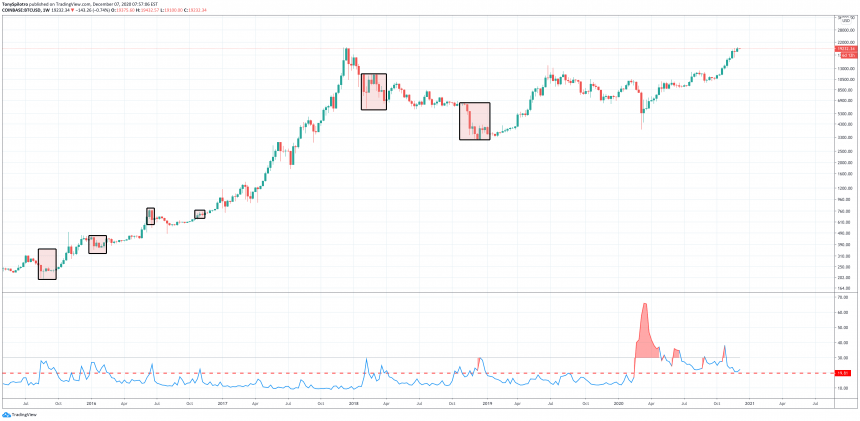Bitcoin price is consolidating just below $20,000. As the last confrontation with $10,000 has shown, consolidation below resistance is typically a bullish event. However, with such strong resistance above, the uncertainty surrounding the pandemic, the coming vaccine, and the change of power happening in the United States, there’s a recipe for rejection as well.
And while signals are mixed and analysts are divided, the VIX volatility index could be warning of an extremely volatile drop to come.
The Bearish Case: VIX Volatility In The Past Triggers Crypto’s Biggest Crashes
The cryptocurrency market is confused currently. After chaotic capitulation on Black Thursday, Bitcoin has done the unthinkable and risen from under $4,000 to nearly $20,000 in a year underscored by uncertainty, fear, and a pandemic, unlike the modern world has ever witnessed.
The world first learning of what was to come in March 2020, triggered the Black Thursday panic selloff that cut the leading cryptocurrency by market cap down by over 60% in days.
Related Reading | “Cyclical Nature Of Bitcoin” Could Provide Clues On Continuation Or Correction
The burst of volatility – measured by the VIX – is the largest in the asset’s young history. Bitcoin was born during The Great Recession, and the VIX hasn’t had anywhere near as sharp a spike as then, until 2020.

The VIX rose above a reading of 20 during most Bitcoin crashes historically | Source: BTCUSD on TradingView.com
The Volatility Index on Black Thursday spike to above a reading of 20, and has remained there since. The metric touched down on the key level, before beginning to turn back up – potentially signaling volatility ahead.
And this could be a bad sign with Bitcoin trading below its most powerful resistance yet of $20,000. According to the chart above, most instances of the VIX rising beyond a reading of 20 has led to a sharp selloff in crypto. While the market is at extreme exuberance, could this happen again?
The Bullish Case: Bitcoin Historic Volatility Begins To Grow, Could Resolve to The Upside
Volatility is defined by Investopedia as a representation “of how large an asset’s prices swing around the mean price,” adding that it is a “statistical measure of its dispersion of returns.”
As the definition explains, volatility can move in either direction and doesn’t necessarily mean a drop. Bitcoin is considered one of the most volatile assets in history, yet even though it is testing $20,000, certain tools show volatility is extremely low.
The resolution of low volatility phases often results in periods of heightened volatility. This is measured by several technical indicators and is expressed in how tightly coiled or how wide the Bollinger Bands are. Bollinger Band Width is a separate tool focused on only this.

Several volatility measuring tools show Bitcoin as historic lows | Source: BTCUSD on TradingView.com
According to the tool and historical volatility, Bitcoin’s bull run hasn’t even really started yet in terms of the volatility it will soon bring.
Related Reading | Bitcoin Intraday Volatility Explodes, But Historically Is Only Just Getting Started
Looking at past cycles and related measurements on each tool definitely demonstrates how little volatility is there currently by comparison. The largest increases in volatility in Bitcoin has always led to bull markets on the grandest scales. The VIX and the pandemic are unusual factors that weren’t applicable to past cycles, so anything is possible.
And while the signals are mixed and analysts are indeed divided, there is a chance they are both right – Bitcoin is going to go down and up – many, many times from here on out – until the asset has topped and it all starts over again.
Featured image from Deposit Photos, Charts from TradingView.com

